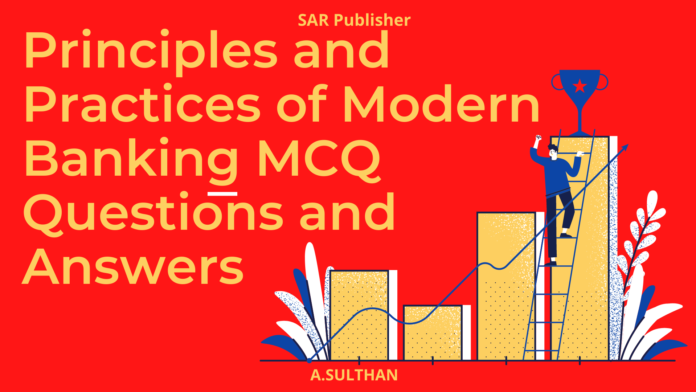Principles and Practices of Modern Banking MCQ Questions and Answers Part – 1
Principles and Practices of Modern Banking MCQ Questions and Answers Part – 2
Principles and Practices of Modern Banking MCQ Questions and Answers Part – 3
101. A person who is named in ‘Will’ to administer the estate of the deceased after his death is called _________.
A. The administrator
B. The executor
C. The manager
D. The liquidator
ANSWER: B
102. A convenient way of making a purchase or paying for a service without holding cash is called as
A. Electronic Payment System
B. Electronic Clearing Service
C. National Electronic Fund Transfer
D. Electronic Fund Transfer
ANSWER: A
103. —- constitutes the foremost element of an electronic payment system
A. Banker
B. Customer
C. Merchant
D. Shopping mall
ANSWER: B
104. An electronic payment device that involves the use of networking services where by the e-customer issues digital cheques to e-merchant malls to settle transactions carried over the internet is known as
A. Electronic cash
B. e-purse
C. Digital cheques
D. Electronic card
ANSWER: C
105. Electronic cash is also called as
A. Hot money
B. Digital money
C. Instant money
D. Easy money
ANSWER: B
106. A wallet-sized smart card, embedded with programmable chip which storeds e-money to be used in a
virtual trading environment for making payment is called
A. Electronic card
B. Digital card
C. Electronic purse
D. Electronic cash
ANSWER: C
107. Use of personal computers at home for conducting their banking operation with their banks is called
A. Mobile Banking
B. Anywhere Banking
C. Internet Banking
D. Home Banking
ANSWER: D
108. ———-is popularly known as Plastic cards or Plastic money
A. Smart cards
B. Electronic cards
C. Credit cards
D. Debit cards
ANSWER: C
109. Credit cards first emerged in 1920s
A. India
B. China
C. USA
D. UK
ANSWER: C
110. Which of the first subsidiary bank of State Bank of India to do whole computerization of all its branches?
A. State Bank of Patiala
B. State Bank of Hyderabad
C. State Bank of Saurashtra
D. State Bank of Travancore
ANSWER: A
111. In which year, MICR system for cheque was implemented in India?
A. 1987
B. 1996
C. 1990
D. 1993
ANSWER: A
112. Which is the first bank to introduce Credit card in India?
A. Bank of India
B. Global Trust Bank
C. IndusInd Bank
D. Central Bank of India
ANSWER: D
113. Which is the first bank to launch Debit card in India?
A. Standard Chartered Bank
B. Citi Bank
C. . ABN Amro Bank
D. American Express Bank
ANSWER: B
114. Which was the first Joint Stock Bank established by an Indian establishment?
A. Bank of Bombay
B. Oudh Commercial Bank
C. Bank of Hindustan
D. Hindustan Commercial Bank
ANSWER: C
115. Which is the first change in banking sector of India after independence?
A. Nationalization of Banks
B. Social control on Banks
C. Establishment of SBI
D. Establishment of RBI
ANSWER: B
116. When were the banks nationalized in our country?
A. On 1st July 1965
B. On 19th July 1969
C. On 19th July 1969 and 15th April 1980
D. On 16th April 1980 and 1st July 1965
ANSWER: C
117. What are the major change in banking sector of India after nationalization of Banks?
A. Expansion of bank branches
B. Cut throat competition in Banking sector
C. Introduction of Banking Regulation Act
D. Establishment of RBI
ANSWER: A
118. The following one is absolutely essential for a special crossing
A. Two parallel transverse lines
B. Words “And company?
C. Words “Not negotiable”
D. Name of a banker
ANSWER: D
119. The reasonable period allowed in India for the presentation of a cheque is
A. 1 year
B. 3 months
C. 9 months
D. depending upon custom
ANSWER: B
120. If cheque is crossed an account payee, this is direction of __________ to _______.
A. Payee, paying banker
B. Payee, collecting bank
C. Drawer, paying bank
D. Drawer, collecting bank
ANSWER: D
121. Which of the following is not the form of E-banking?
A. Internet Banking
B. Direct Deposit in Bank
C. Electronic cheque conversion
D. Mobile banking
ANSWER: B
122. What was the capital of RBI at the time of Its promotion?
A. 7 crores
B. 5 crores
C. 10 crores
D. 25 crores
ANSWER: B
123. Interest payable on savings bank accounts is?
A. Regulated by State Governments
B. De-regulated by RBI
C. Regulated by RBI
D. Regulated by Finance Minister
ANSWER: B
124. The usual deposit accounts of banks are
A. Current accounts, electricity accounts and insurance premium accounts
B. Current accounts, post office savings, bank accounts and term deposit accounts
C. Loan accounts, savings bank accounts and term deposit accounts
D. Current accounts, savings bank accounts and term deposit accounts
ANSWER: D
125. Fixed deposits and recurring deposits are __________.
A. Repayable after an agreed period
B. Repayable on demand
C. Repayable after 15 days
D. Repayable on demand or after an agreed period as per bank’s choice
ANSWER: A
126. Accounts are allowed to be operated by cheques in respect of __________.
A. Both savings bank accounts and fixed deposit accounts
B. Both Savings bank accounts and current accounts
C. Both savings bank accounts and loan accounts
D. Other savings bank accounts and cash accounts only
ANSWER: B
127. Which of the following is correct statement?
A. No interest is paid on current deposit accounts
B. Interest is paid on current accounts at the same rate as term deposit accounts
C. The rate of interest on current accounts and savings accounts are the same
D. No interest is paid on any deposit by the bank
ANSWER: A
128. When a bank returns a cheque unpaid, it is called __________.
A. Payment of the cheque
B. Drawing of the cheque
C. Dishonour of the cheque
D. Taking of the cheque
ANSWER: C
129. Largest shareholder (in percentage shareholding) of a Nationalized bank is ?
A. RBI
B. NABARD
C. Government of India
D. LIC
ANSWER: C
130. An institution whose principal business is accepting deposits and forwarding loans is called
A. Mutual Fund Business
B. Company
C. . Bank
D. Ombudsman
ANSWER: C
131. Which of the following term do not represent any part of Banking technology?
A. NEFT
B. RTGS
C. ITC
D. EPS
ANSWER: C
132. The normal activities of the bank do not include
A. Providing loans
B. Accepting deposits
C. Providing lockers
D. Selling real estate properties
ANSWER: D
133. Which one of the following can be accepted as proof of address while opening of an account?
A. Voter ID
B. Driving Licence
C. Passport
D. All of the above
ANSWER: D
134. Which electronic fund transfer system run on the basis of “Deferred Net Settlement”
A. NEFT
B. RTGS
C. SMS
D. BIFSC
ANSWER: A
135. In both cases of RTGS and NEFT, the service charges are decided by
A. Customer
B. IMF
C. Banker
D. Transferee
ANSWER: C
136. The bank which was not nationalized in 1969 ____________.
A. Punjab National Bank
B. Oriental Bank of Commerce
C. CBank of Baroda
D. Union Bank of India
ANSWER: B
137. Which of the following is not the name of the bank functioning in India?
A. Central Bank of India
B. UCO Bank
C. Aegon Religare
D. Dena Bank
ANSWER: C
138. RBI is known as lender of last resort because
A. It has to meet the credit need of citizen to whom no one else willing to lend
B. Bank lend to go to RBI as a last resort
C. It comes to help banks in times of crisis
D. All of the above
ANSWER: C
139. Cheque is payable on
A. Demand
B. Usage
C. Fixed future date
D. After sight
ANSWER: A
140. Board for Financial supervision was constituted in the year _________.
A. 1994
B. 1997
C. 2004
D. 2011
ANSWER: A
141. Electronic purse may have the following number of storage space
A. Only one
B. Two
C. Several
D. No storage space
ANSWER: C
142. The click and portal model facilitates are
A. Traditional banking
B. Paperless banking
C. Virtual banking
D. Both b and c
ANSWER: D
143. Electronic payment system is a/an _____________.
A. Software
B. Hardware
C. Application
D. Package
ANSWER: C
144. What are the major change in banking sector of India after nationalization of Banks?
A. Expansion of bank branches
B. Cutthroat competition in Banking sector
C. Introduction of Banking Regulation Act
D. Establishment of RBI
ANSWER: A
145. Which one of the following instruments is not used in bank transaction?
A. Cheque book
B. pay in slip
C. passbook
D. PAN
ANSWER: D
146. Which committee has recommended the introduction of Smart card?
A. Rangarajan Committee
B. Saraf Committee
C. Nayak Committee
D. Pannirselvam Committee
ANSWER: B
147. A _________ card is used to obtain cash, goods or services automatically debiting the payments to the cardholders bank account instantly up to the credit balance which exists in the customers bank account.
A. Credit
B. Gold
C. Debit
D. Business
ANSWER: C
148. ———-are workstations that act as a nucleaus of the functioning of the telephone banking system
operated through fully computer-integrated telephone system
A. Telephone centre
B. Enquiry centre
C. Computer centre
D. Call centre
ANSWER: D
149. ——-is the most favoured technology for secure Internet banking service
A. Public Key Instructions
B. Public Key Information
C. Public Key Infrastructure
D. People Key Infrastructure
ANSWER: C
150. AVR technology is used in _________.
A. Internet banking
B. E-banking
C. Mobile Banking
D. Telephone banking
ANSWER: D


